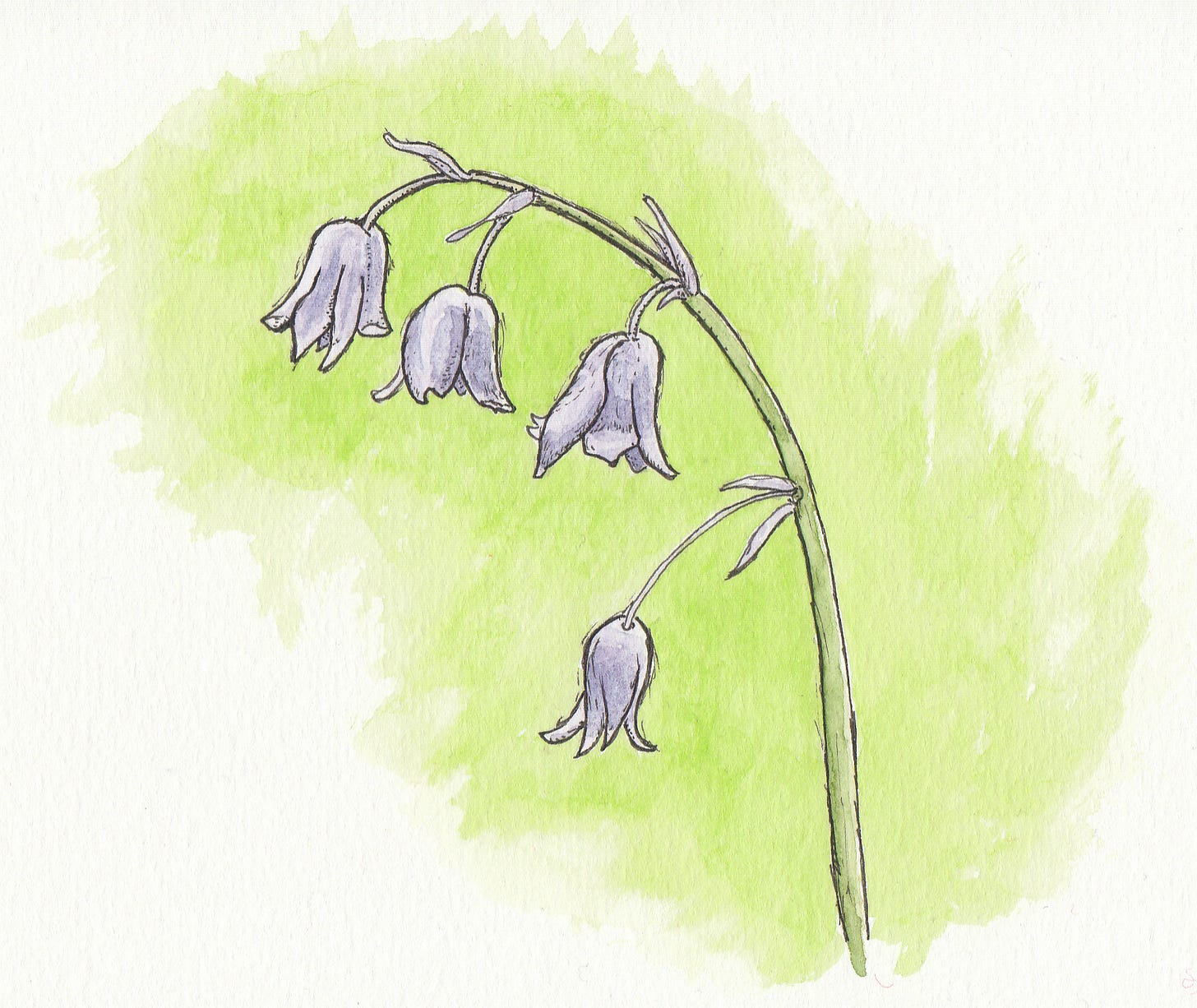Hello friends, familiar and new, and welcome to a house in a hamlet in a forest. I’m Jan and I hold spaces for those on journeys of transformation. I believe story is powerful and that the earth offers healing through our daily connection and herbal allies. My Sunday posts are always free and you are so welcome here. Let’s create a little alchemy together.
You might find this easier to read in the app or online as some mail providers will cut off the text.
Recently, reading Eowyn Ivey's beautiful novel, Black Woods, Blue Sky, I was perplexed when one of the characters, knowledgeable in herbs, shows a child how to eat bluebell flowers. No! Surely not. Bluebells are poisonous to ingest -- root, leaf and flower. But then there is the Latin name and he also calls the 'bluebells' lungwort.
Ah — so not Hyachinthoides non-scripta, the bluebells of the woods of my childhood or the woods in Betws-y-coed near where I lived in Wales... the bluebells that are dotted in thick clumps along the track I take through the forest outside my door most days.
The bluebells in Alaska, where Black Woods, Blue Sky is set, are of the Mertensia group, a genus related to, but separated from the Pulmanaria genus in the late 18th century.
Mertensia has edible flowers and leaves, though the leaves, which are soft and hairy are not as palatable as the flowers. It's traditionally used to increase milk flow in lactation and the roots can be powdered to help with itching rashes. It's also known as mountain bell and many other names, though I've never previously heard it called lungwort despite being closely related.
So the Latin trail led me to lungwort and lungwort-related herbs. (And reminded me why the Latin names and careful identification are so important before taking a herb internally.
Pulmonaria officinalis, which I do know as lungwort, is a powerful inflammatory modulator. A herb that nourishes and is a wonderful tonic herb.
A soother — from heart palpitations to sore skin, from an upset digestive system to connective tissue, from kidney infections to the urinary tract.
And, of course, the lungs. Whether the respiratory imbalance is congestion or a cough, flu or a throat infection... lungwort offers support to the lungs and calm inflammation.
Mucilaginous, an astringent tonic and bursting with minerals, lungwort's actions share common threads:
soothe
calm
soften
breathe
In Europe, lungwort has been common since the sixteenth century and before that the Pulmonaria longifolio was native to the UK, France, Spain and Portugal.
And then there is Hyachinthoides non-scripta. Please do not ingest this plant. But do spend time with her (or for you, s/he might be he or they or...)
This bluebell, the one I grew up with and have always known as poisonous (though I have no idea how, as it wasn't something my parents would ever have known or shared)... is an enchanter, a gentle mischief-maker, a heady, dreamy, playful companion.
Bell bottle
Dog's leek
Fairy Bells
Goosey gander
Wild hyacinth
Blue Trumpet
Snapgrass
Crow bells
Squill
Cuckoo's boots
Witches' thimbles
Lady's nightcap
English bluebells
As a herbalist, my instinct is to think about how we can take a herb into our bodies as an ally on journeys of wellness and transformation. But I'm increasingly fascinated with herbs that can be used in drop doses or in negligible physical amounts to effect subtle or deeper changes in resonance with our inner journeys. And I'm fascinated with the way simply spending time with a plant that we would not ingest at all, just as we would with a friend or lover, with a familiar cat or dog... also works an effect on us.
English bluebells (Hyachinthoides) are part of the Asparagus family, whereas Pulmonaria and Mertensia bluebells are in the Borage family. English bluebells, unlike the lungworts, are toxic. And English bluebells have more folkloric and emotional-spiritual associations.
Bluebell rings are faery rings that enchant those who step inside. They scintillate with childhood links -- playfulness, wonder, daydreaming, those trance-like reveries we fall into dozing in a warm woodland... They have a sense of letting go of inhibitions, the inner child and story telling.
The roots of bluebells ooze a pungent viscous liquid that is a strong glue traditionally used in bookbinding. In the thirteenth centtury, words were glued together into new enchantments by these powerfully dreamy plants. (Though don't try this at home — the 'glue' is also toxic and can cause dermatitis).
The threads of bluebell are:
play
child's view
dream
enchantment
reverie
liminal
trance
inspiration
With no ingestion needed.
And yet despite these cautions and the major differences between lungworts and wild hyacinths, the many shades of bluebell share a thread in our breath.
Whether through deep soothing or play, whether through soft calming or liminal enchantment, all shades of of bluebell return us to how we are breathing...
Lungworts physically assist the breath, and in doing so they calm the nervous system. We breathe more easily on every level.
Bluebells of Celtic woods, the Hyacinthoides, return us to a simpler perspective, a more open spirit. We breathe freely and deeply into wonder and ease.
Visit a bluebell wood at dusk.
Breathe deeply.
Enchantments can be malign or benign — sit with bluebell and, afterwards, journal about what enchants you down paths that do not serve you. And what enchants you along paths of wonder and wellness?
Breathe deeply.
If you would like to explore ways to work with me herbally, DM me.






I love the idea of spending time with herbs as we would with any living being on earth…